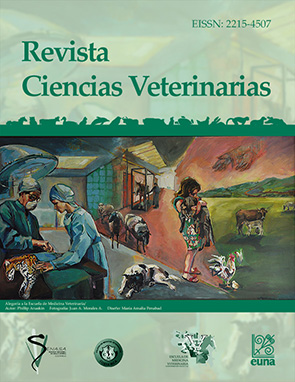Equine thoracic wall trauma and management of pneumothorax: report of a clinical case attended under field conditions
DOI:
https://doi.org/10.15359/rcv.33-2.2Keywords:
thoracic trauma, pneumothorax, standing horse, field conditions, depressurize, pleural cavity, Costa RicaAbstract
Various causes of accidental trauma affecting the equinethoraxic wall and the pathophisiology of pneumothorax are mentioned.Diagnosis techniques, as well as medical and surgical management of the clinical case on a standing horse under field conditions are discussed. Two options used to depressurize the pleural cavity are explained. The paper also mentions the advantages of handling the case under local anesthetic techniques versus general anesthesia. All the procedures were performed at a farm located in the canton of Coronado, Costa Rica.References
Axon, J.E. 2010. Traumatismo torácico. In B.P. Smith (ed). Medicina Interna de Grandes Animales, Elsevier, Barcelona. p. 551-553.
Bellezzo, F., Hunt, R.J., Probost, R., Bain, F.T. & Kirker-Head, C. 2004. Surgical repair of rib fractures in 14 neonatal foals: case selection, surgical technique and results. Equine Vet J.36:557.
Boy, M.G. & Sweeney, C.R. 2000. Pneumothorax in horses: 40 cases (1980–1997). J. Am Vet Med Assoc. 216:1955–1959.
Budras, K., Sack, W.O. & Rock, S. 2009. Thoracic cavity. In Budras, K., Sack, W.O., Rock, S., (eds.), Anatomy of the horse, 5th edition. Hannover (Germany): Schlutersche Verlagsgesellschaft mbH & Co KG. p.60.
Butler, J.A., Colles, C.M., Dyson, S.J., Kold, S.E. & Poulos, P.W. 2003. Clinical Radiology of the Horse, Second Edition, Blackwell Science, Oxford. p. 485, 486-503.
Clayton, H.M., Flood, P.F. & Rosenstein, D.S. 2007. Anatomía Clínica del Caballo. Elsevier, Amsterdam. p. 89-96.
Getty, R. 1975. Sisson and Grossman’s The Anatomy of Domestic Animals. 5th Edition. WB Saunders, Philadelphia.
Hance, S.R. & Robertson, J.T. 1992. Subcutaneous emphysema from an axillary wound that resulted in pneumomediastinum and bilateral pneumothorax in a horse. J Am Vet Med Assoc. 200:1107.
Hardy, J. 2004. Emergency Procedures and First Aid. p. 1185. In K.W. Hinchcliff, A.J. Kaneps & R.J. Geor, (eds.). Equine Sports Medicine and Surgery. Saunders, Edinburgh.
Hassel, D.M. 2007. Thoracic Trauma in Horses. Veterinary Clinics of North America: Equine Practice. 23(Issue 1): 67-80.
Hendrickson, D.A. 2006. Management of Deep and Chronic Wounds. p. 299-305. In J.A. Auer & J.A. Stick, (eds.). Equine Surgery. 3rd Edition. Saunders Elsevier, St Louis Missouri.
Jeffcott, L.B. 2009.The Normal Anatomy of the Osseus Structures of the Back and Pelvis. p. 3-15. In F.M.D. Henson, (ed.). Equine Back Pathology Diagnosis and Treatment. Wiley-Blackwell, Oxford.
Knottenbelt, D.C., Holdstock, N. & Madigan, J.E. 2004. The foal at the delivery. p. 65-74. In D.C. Knottenbelt, (ed.). Equine Neonatology: Medicine and Surgery. Saunders, Philadelphia.
Laverty, S., Lavoie, J.P., Pascoe, J.R. & Ducharme, N. 1996. Penetrating wounds of the thorax in 15 horses. Equine Vet J. 28:220–224.
Laverty, J.D. & Halley, J. 1999. Thoracic trauma in newborn foals. Equine Vet J. 31:149.
Left, A.R. & Schumacher, P.T. 1993. Respiratory Physiology: Basics and Applications. WB Saunders, Philadelphia.
Lugo, J. 2006. Thoracic Disorders. p. 616-623. In J.A. Auer & J.A. Stick, (eds.). Equine Surgery. 3rd Edition. Saunders Elsevier, St Louis Missouri.
Maud-Aline, C., Aprea, F. & Clutton, E. 2012 June. Anesthetic management of a horse with traumatic pneumothorax. Can Vet J. 53(6):648-652.
McDonell, W.N. & Kerr, C.L. 2007. Respiratory System. p. 117-151. In Tranquilli, W.J., Thurmon, J.C. & Grimm, K.A. (eds.). Lumb & Jones Veterinary Anesthesia and Analgesia. 4th Edition. Blackwell Publishing, Iowa.
Peroni, J.F., Horner, N.T., Robinson N.E. & Stick, J.A. 2001. Equine thoracoscopy: normal anatomy and surgical technique. Eq Vet J. 33 (3):231-237.
Reef, V.B., Boy, M.G., Reid, C.F. & Esler, A. 1991. Comparison between diagnostic ultrasonography and radiography in the evaluation of horses and cattle with thoracic disease: 56 cases (1984-1985). J Am Vet Med Assoc. 198:2112.
Robinson, N.E. 2007. How horses breathe: The respiratory muscles and the airways. p.19–31. In McGorum, B.C., Dixon, P.M., Robinson N.E. & Schumacher, J. (eds.). Equine Respiratory Medicine and Surgery. Saunders Elsevier, Philadelphia.
Schambourg, M.A., Laverty, S. & Mullim, S. 2004. Thoracic trauma in foals: Postmortem findings. Equine Vet J.35:78.
Sprayberry, K.A. & Barrett, E.J. 2015. Thoracic trauma in horses. Vet Clin Equine 31: 199-219 or Vet Clin Equine 31 (2015) 199-210, Según DOI
Stone, W.C., Trostle, S.S. & Gerros, T.C.1994. Use of a primary muscle pedicle flap to repair a caudal thoracic wound in a horse. J Am Vet Med Assoc. 205:828.
Trigo, P., Muñoz, A., Castejón, F., Riber C. & Hassel, D.M. 2011 (Nov). Rib fracture in a horse during an endurance race. Can Vet J. 52(11):1226-1227.
Weaver, M. & Barakzai, S. 2009. Radiographs of the thorax. p.161-167. In Handbook of Equine Radiography, Saunders Elsevier, U.K.
Downloads
Published
How to Cite
Issue
Section
License
Licensing of articles
All articles will be published under a license:

Licencia Creative Commons Atribución-NoComercial-SinDerivadas 3.0 Costa Rica.
Access to this journal is free of charge, only the article and the journal must be cited in full.
Intellectual property rights belong to the author. Once the article has been accepted for publication, the author assigns the reproduction rights to the Journal.
Ciencias Veterinarias Journal authorizes the printing of articles and photocopies for personal use. Also, the use for educational purposes is encouraged. Especially: institutions may create links to specific articles found in the journal's server in order to make up course packages, seminars or as instructional material.
The author may place a copy of the final version on his or her server, although it is recommended that a link be maintained to the journal's server where the original article is located.
Intellectual property violations are the responsibility of the author. The company or institution that provides access to the contents, either because it acts only as a transmitter of information (for example, Internet access providers) or because it offers public server services, is not responsible.







